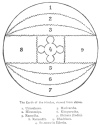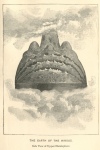
Sacred Texts Earth Mysteries Index Previous Next
Buy this Book at Amazon.com


Paradise Found, by William F. Warren, [1885], at sacred-texts.com
The reader cannot have failed to be struck, as the first explorers of Sanskrit literature have been, with the close analogy, we night even say the perfect identity, of all the essential features of the typical description of Mount Meru in the Puranas with the topography of Eden in the second chapter of Genesis. The garden of Eden (gan-Eden), the garden of God (gan-Elohîm, Ezek. xxviii. 13), which is guarded by the anointed and protecting Kerub (Ezek. xxviii. 14, 16), is placed, like the garden of delight of the gods of India, on the summit of a mountain, the holy mountain of God (har qodesh Elohîm) (Ezek. xxviii. 14, 16), all sparkling with precious stones (Ibid.). 1—Lenormant.
In what kind of a world lived the ancient Brahman? And what was his conception of the location of the cradle of the race?
One of the oldest of the elaborate geographical treatises of India is the Vishnu Purana. Taking this as a guide, let us place ourselves alongside one of the ancients of the country, and look about us.
First, we will look to the South, far down the Indian Ocean. What was supposed to lie in that
direction? To begin with their distribution of the different quarters of the world among the gods, this is the quarter belonging to Yama, the god of the dead:—
In precise accordance with our Key to Ancient Cosmology, it is the direction of descent. North is upwards (uttarāt), south is downwards (adharāt) 2 Hence the abode and kingdom of Yama is not only to the south, but also below the level of India, i.e., on the under hemisphere, or, as Monier Williams locates it, in "the lower world." 3 All Hindu literature is full of similar references. The exact time required for the soul's journey was supposed to be four hours and forty minutes. 4
In this direction, evidently, we shall vainly seek a paradise. Let us turn to the North and "ascend."
[paragraph continues] First, of course, we come to the Himalaya range, the Himavat of Indian geography. All that portion of the earth lying between this mountain range and the great ocean to the South constitutes one of the seven, or nine, "varshas," or divisions of the habitable (upper) hemisphere. Its name is Bhârata. If now our ancient Hindu could proceed due North and cross the Himavat,—which he does not think possible to mortals,—he would find himself in Kimpurusha, an equally extensive but more elevated and beautiful varsha, extending northward till bounded by a second range of incredibly lofty mountains, the Himakuta. Still "ascending," or going North, until he had crossed this division and passed the Himakuta, he would enter Harivarsha, a still loftier and diviner country. This extends, in turn, to another boundary range, the Nishadha, crossing which one would come to Ilâvrita, the central varsha of all, which occupies the top as well as the centre of the world. To the adequate description of the beauty and glory and preciousness of this country no tongue is equal. In its centre is situated the mount of the gods, "Beautiful Meru," described in chapter first of the present Part. It is at the Pole, and around it revolve all constellations of heaven. It is the centre of the habitable world.
Continuing our imaginary journey across this divine country of Ilâvrita, crossing of course this colossal central mountain, we should now begin to descend on the meridian opposite to that on which we ascended on the India side of the globe. The boundary of the central region on that side is the Nila range, then comes the varsha of Ramyâka; its farther boundary is the Sweta range, beyond which
is the varsha of Hiranmâya. Still descending, we cross this and the range which bounds it on the farther side, the Sringin, and we are in Uttarakuru, the last of the seven grand divisions of the earth, the one corresponding, in distance from Meru, to Bhârata, or our starting-point. It, of course, is on the equatorial ocean, and here too we have only to cross this ocean in order to reach the underworld.
The way in which the varshas are made to number "nine" is by subdividing the great central cross-section of the hemispherical surface, leaving Ilâvrita a perfect square on the top of the globe, the land descending eastward to the sea being called Bhadrâsva, and the corresponding country to the West being called Ketumâlâ.
To assist the reader to a clearer conception of this sacred geography we give herewith two cuts, one of which presents in outline the side-aspect of the Puranic earth, and the other a flat polocentric projection of its upper hemisphere. 1
Having now answered our first question, and showed in what kind of a world the ancient Hindu lived, we pass to the second: "What was his conception of the location of the cradle of the race?"
The question is answered the moment we say that in the Hindu conception and tradition man proceeded from Meru. His Eden-land was Ilâvrita. It was therefore at the Pole.
How strange that Lenormant could have written the following, and still have imagined that the true primeval Eden of the Hindu was anywhere else than at the terrestrial Pole! He says, "In all the legends
of India the origin of mankind is placed on Mount Meru, the residence of the gods, a column which unites the sky to the earth. . . . At first sight, on reading the description of Mount Meru furnished by the Puranas, it appears overcharged with so many purely mythological features that one hesitates

Click to enlarge
The Earth of the Hindus, viewed from above.
The Earth of the Hindus, viewed from above
1. Uttarakuru. 5. Harivarsha.
2. Hiranmâya. 6. Kimpurusha.
3. Ramyâka. 7. Bhârata (India).
8. Ketumâlâ. 9. Bhadrâsva.
4. SU-MERU in Ilâvrita.
to believe that it has any basis in reality. To realize these descriptions one must represent one's self in the centre of a vast level and very elevated surface, surrounded by various mountain-ranges, a gigantic block, the axis of the world, raising its head to the highest point of the heavens, whence there

Click to enlarge
THE EARTH OF THE HINDUS.
Side View of Upper Hemisphere.
falls upon its summit, on the North Pole, the divine Gangâ, the source of all rivers, which there discharges itself into an ideal lake, the Mânasa-Sârovara. . . . Meru, then, is at one and the same time the highest part of the terrestrial world and the central point of the visible heaven,—the two having been confounded through ignorance 1 of the real constitution of the universe: it is also, at one and the same time, the north pole and the centre of the habitable earth, Jambu-dwîpa,—literally of the continent of the tree Jambu, the tree of life. Leaving the higher basin of the mountain in which its waters have at first collected the source, Gangâ travels seven times round the Meru in descending from the abode of the seven Rishis of the Great Bear, to empty itself afterward into four lakes placed on four summits adjacent to this vast pyramid, and serving as buttresses on its four sides. . . . Fed by the waters of the celestial Gangâ the four lakes in their turn feed four terrestrial rivers which flow out through the mouths of four symbolical animals. These four great rivers water as many distinct regions, . . . and discharge themselves into four opposite seas, to the east, south, west, and north of the central Meru. . . . The four lakes, the four rivers, and the four oceans are composed of different liquids, corresponding to the four castes, and these latter, with which are connected all the nations of the human race, are reputed to have set out from the four sides of Meru to people the whole earth." 2
A similar illustration of the power of a wrong prepossession is given us in the illustrious Carl Ritter, who after expressly declaring that "the numberless Puranas and their most diverse interpretations by the Pundits teach that Meru is the middle of the earth, and itself literally designates its centre and axis," 1 thereupon in the coolest manner imaginable proceeds to identify the same sacred height with the mountains of Central Asia. Still worse is the procedure of Mr. Massey, who after locating the Garden of Eden on Mount Meru, and saying explicitly, "The Pole, or polar region, is Meru," and again, "Meru is the garden of the Tree of Life," nevertheless tells us that in equatorial Africa beasts first grew into men. 2 Happier is the inconsistency of Mr. Lillie, who, despite his adhesion to the flat-earth theory of Hindu cosmology, still incidentally speaks of "the blissful Garden" as "at the Pole." 3
148:1 The continuation of the passage is as follows: "The Jehovistic writer does not say so in Genesis, but the prophets are express in this respect. The tree of life grows 'in the midst of the garden' (bethoch haggan) with the tree of the knowledge of good and evil (Gen. ii. 9; iii. 3), exactly like the tree Jambu, in the centre of the delightful plateau which crowns the height of Meru. A river goes out of Eden to water the garden, and from thence it divides and forms four arms (Gen. ii. so). This corresponds in the most precise manner with the way in which the spring Gangâ, after having watered the Celestial Land, or the Land of Joy at the summit of Meru, forms four lakes on the four counterforts of this holy mountain, whence it afterwards flows out in four large rivers toward the four cardinal points."
149:1 Griffiths, Ramayana, ii. 20.
149:2 Zimmer, Allindisches Leben. Berlin, 1879: p. 359.
149:3 Yama: "one of the eight guardians of the world as regent of the South quarter, in which direction in some region of the lower world is his abode called Yama-pura; thither a soul, when it leaves the body, is said to repair, and there, after the recorder, Citra-gupta, has read an account of its actions, kept in a book called Agra-Sandānī, receives a just sentence, either ascending to heaven, or to the world of the Pitris, or being driven down to one of the twenty-one hells."—Williams, Sanskrit Dictionary, sub. "Yama."
149:4 "The soul is believed to reach Yama's abode in four hours and forty minutes; consequently a dead body cannot be burned until that time has passed after death."—W. J. Wilkins, Hindu Mythology, Vedic and Puranic. London, 1882: Art. "Yama." See, also, Muir, Sanskrit Texts, v. 284-327, and our references in "Homer's Abode of the Dead."
151:1 See also Appendix, Sect. IV., "The Earth and the World of the Hindus."
153:1 Lenormant here follows the misleading arguments of Wilford in Asiatic Researches, vol. viii., pp. 312, 313.
153:2 The Contemporary Review, Sept., 1881: Am. ed., p. 39. Also Les Origines de l’Histoire, tom. ii. 1, ch. i. Compare Essai de Commentaire des Fragments Cosmogoniques de Bérose. Paris, 1871: pp. p. 154 300-328. Also Muir, Sanskrit Texts, vol. ii., p. 139. "In his Indische Studien, vol. I., p. 165, Weber speaks of the Aryan Indians being driven by a deluge from their home, and coming from the North, not from the West (as Lassen, i., 515 will have it), into India."
154:1 "Die zahllosen Puranas and ihre verschiedenartigsten Auslegungen durch die Pundits lehren, dass Meru die Mitte der Erde sei, and selbst wörtlich auch das Centrum, die Axe, bezeichne."—Erdkunde, Bd. ii., p. 7.
154:2 The Natural Genesis, vol. ii., pp. 28, 162.
154:3 Buddha and Early Buddhism. London, 1882: p. 8.